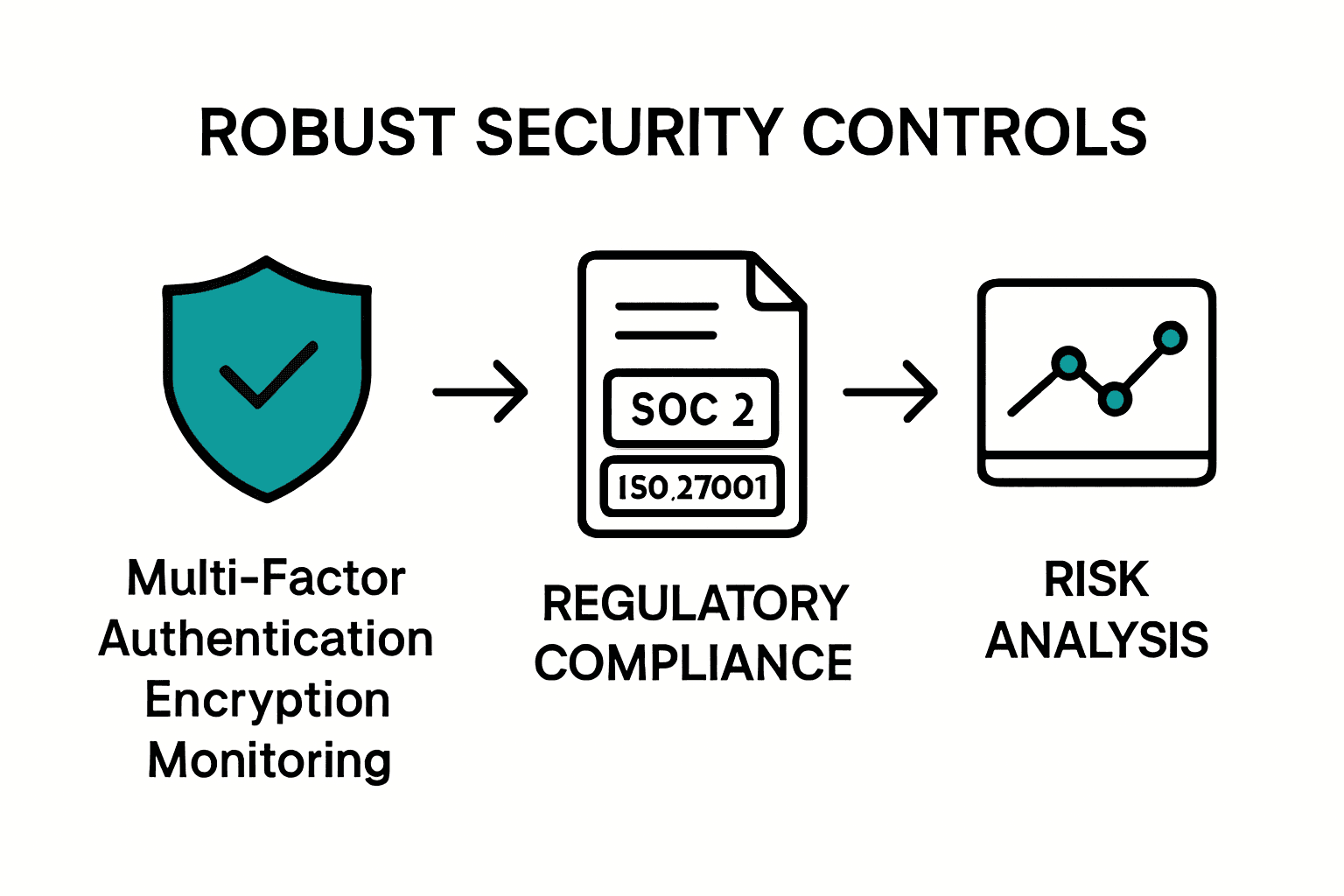12.11.25
Complete Guide to Insurance Platform Security Fundamentals

Cyberattacks cost the insurance industry over $6 billion each year, putting sensitive data and business continuity at risk. With digital platforms now central to insurance operations, even a single security lapse can have dramatic consequences for clients and companies alike. Understanding the core principles of insurance platform security helps organizations defend vital assets, earn customer trust, and navigate an environment where threats evolve faster than ever.
Table of Contents
- Defining Insurance Platform Security Fundamentals
- Core Security Controls and Frameworks
- Cloud-Native Security for Insurance Platforms
- Regulatory Compliance and Data Protection Laws
- Common Threats and Risk Management Strategies
- Best Practices for Secure Integrations and APIs
Key Takeaways
| Point | Details |
|---|---|
| Robust Security Framework | Integrate multi-factor authentication, real-time logging, and granular access controls to protect insurance platforms from unauthorized access. |
| Dynamic Risk Management | Develop adaptable security strategies and continuous monitoring protocols to address evolving cybersecurity threats effectively. |
| Compliance Integration | Implement compliance frameworks like SOC 2 and ISO 27001 to align security practices with regulatory requirements and enhance data protection. |
| Holistic Security Culture | Foster a proactive security culture through ongoing training and awareness to transform security into an organizational capability rather than a reactive measure. |
Defining Insurance Platform Security Fundamentals
Insurance platform security fundamentals represent the critical infrastructure protecting sensitive digital assets within complex insurance technology ecosystems. At their core, these fundamentals encompass a comprehensive strategy designed to safeguard critical systems, customer data, and operational integrity across digital insurance platforms.
According to Zov Solutions, robust security for insurance platforms requires integrating multiple critical components within a secure framework. These essential security elements include:
- Multi-factor authentication to restrict unauthorized system access
- Real-time logging for tracking and monitoring system interactions
- Granular access controls defining precise user permissions
- Comprehensive data encryption protecting information in transit and at rest
Preventing potential security breaches demands a multifaceted approach. Mold Stud recommends implementing stringent protocols that go beyond basic protective measures. These protocols include conducting regular third-party security audits, establishing strict internal threat mitigation strategies, and developing comprehensive encryption strategies that protect sensitive customer and operational data.
Effective insurance platform security is not a static concept but a dynamic, continuously evolving discipline. Insurance technology leaders must remain proactive, anticipating emerging threats and adapting their security infrastructures accordingly. This means investing in ongoing training, staying current with technological advancements, and maintaining a culture of security awareness across all organizational levels.
Core Security Controls and Frameworks
Core security controls and frameworks form the critical backbone of insurance platform security, providing structured approaches to protecting sensitive digital infrastructure and managing technological risks. These comprehensive systems establish standardized methodologies for identifying, preventing, and mitigating potential security vulnerabilities across insurance technology ecosystems.
Vanta highlights how compliance frameworks like SOC 2 and ISO 27001 play a pivotal role in enhancing organizational security posture. These frameworks mandate critical security practices such as:
- Incident response planning to address potential security breaches
- Continuous monitoring of system activities
- Strict access management protocols
- Risk assessment and mitigation strategies
According to Scrut, modern compliance management requires a unified approach that eliminates redundant work while providing flexible control frameworks. This means developing adaptive security strategies that can:
- Align predefined controls with multiple industry standards
- Support custom frameworks tailored to specific organizational risks
- Enable automated compliance tracking
- Facilitate continuous security monitoring
Successful implementation of core security controls demands more than just technological solutions. Insurance organizations must cultivate a holistic security culture that emphasizes ongoing education, proactive risk management, and continuous adaptation to emerging technological challenges. This approach transforms security from a reactive measure to a strategic organizational capability.

Cloud-Native Security for Insurance Platforms
Cloud-native security represents a transformative approach to protecting insurance platforms, moving beyond traditional security models to create more dynamic, scalable, and resilient digital environments. This approach integrates security directly into the cloud infrastructure, enabling insurance organizations to leverage advanced technological capabilities while maintaining robust protective measures.
Policy Cortex highlights the critical role of policy as code and AI-powered policy evaluation in modern cloud governance. These innovative approaches enable insurance platforms to:
- Automate complex compliance controls
- Implement continuous monitoring strategies
- Evaluate security policies dynamically
- Adapt quickly to emerging technological challenges
According to LinkedIn, cloud security solutions like AWS Security Hub and Microsoft Azure Security Center are instrumental in enforcing comprehensive cybersecurity policies. These platforms provide insurance organizations with advanced tools to:
- Manage third-party risk effectively
- Implement holistic security ecosystems
- Monitor and respond to potential security threats in real-time
- Ensure consistent protection across distributed cloud environments
Successful cloud-native security goes beyond technological implementation. It requires a strategic approach that combines advanced tools, comprehensive policies, and a proactive organizational culture focused on continuous learning and adaptation. Insurance platforms must view security not as a static barrier, but as a dynamic, intelligent system that evolves alongside emerging technological landscapes.
Regulatory Compliance and Data Protection Laws
Regulatory compliance and data protection laws form a critical framework that defines how insurance platforms manage, protect, and utilize sensitive customer information. These complex legal requirements establish comprehensive guidelines that ensure the ethical handling of personal data while maintaining robust security standards across digital insurance ecosystems.
Vanta highlights the significance of compliance frameworks like SOC 2 and ISO 27001 in establishing rigorous security standards. These frameworks require organizations to implement critical protective measures, including:
- Comprehensive incident response plans
- Continuous system monitoring
- Strict access management protocols
- Detailed risk assessment strategies
Scrut emphasizes the importance of a unified approach to managing compliance frameworks. Modern insurance platforms must develop adaptive strategies that can:
- Align controls across multiple regulatory standards
- Create custom frameworks addressing unique organizational risks
- Automate compliance tracking processes
- Enable real-time continuous monitoring
Navigating the intricate landscape of regulatory compliance demands more than mere technical implementation. Insurance organizations must cultivate a holistic approach that integrates legal requirements, technological capabilities, and organizational culture. This means developing a proactive compliance strategy that views regulatory adherence not as a burden, but as a fundamental component of building trust and protecting customer interests.
Common Threats and Risk Management Strategies
Insurance platforms face a complex landscape of evolving cybersecurity threats that demand sophisticated, proactive risk management approaches. The digital transformation of insurance systems has simultaneously expanded operational capabilities and introduced intricate vulnerabilities that require comprehensive protective strategies.
arXiv highlights the critical importance of data-driven risk assessment in cyber insurance underwriting. Understanding the nuanced data types that contribute to premium calculations and claims decisions becomes paramount in developing effective risk mitigation strategies. Key considerations include:
- Comprehensive data gathering techniques
- Advanced predictive risk modeling
- Dynamic premium calculation frameworks
- Granular claims decision processes
arXiv introduces an innovative approach to managing systemic cyber risks through artificial cyber lab simulations. These advanced modeling techniques reveal critical insights into cybersecurity interventions, emphasizing that insurance platforms must:
- Implement topology-based security measures
- Develop adaptive resilience strategies
- Understand interconnected risk landscapes
- Create proactive regulatory compliance mechanisms
Successful risk management transcends technological solutions. Insurance organizations must cultivate a holistic ecosystem that combines advanced technological tools, continuous learning, and a culture of adaptive security awareness. This approach transforms risk management from a reactive discipline to a strategic organizational capability that anticipates and neutralizes potential threats before they materialize.

Best Practices for Secure Integrations and APIs
Secure integrations and APIs represent the critical connectivity infrastructure that enables modern insurance platforms to communicate, share data, and deliver seamless digital experiences. As technological ecosystems become increasingly interconnected, implementing robust security measures becomes paramount to protecting sensitive information and maintaining operational integrity.
Loro Journals highlights the importance of implementing zero-trust security models for insurance platform integrations. This approach requires continuous validation and strict authentication at every interaction point. Key strategies include:
- Implementing comprehensive API governance frameworks
- Developing granular access control mechanisms
- Establishing robust encryption protocols
- Creating continuous validation checkpoints
Mold Stud emphasizes the critical importance of protecting data through comprehensive security practices. Insurance platforms must prioritize:
- Encrypting data during transit and at rest
- Conducting regular third-party security audits
- Implementing strict access control measures
- Developing proactive threat mitigation strategies
Successful API and integration security transcends technological implementations. Insurance organizations must cultivate a holistic approach that combines advanced technical controls, continuous monitoring, and a culture of security awareness. This means treating integrations not just as technical connections, but as strategic risk management opportunities that require ongoing attention, refinement, and adaptive thinking.
Strengthen Your Insurance Platform Security with IBA’s Cloud-Native Solutions
Protecting sensitive data and ensuring seamless regulatory compliance are critical challenges outlined in the Complete Guide to Insurance Platform Security Fundamentals. The article highlights complex pain points such as managing multi-factor authentication, real-time monitoring, granular access controls, and automated compliance frameworks. If you are striving to build a resilient, adaptive insurance platform that safeguards customer trust and supports rapid innovation, these demands can feel overwhelming.
IBA understands these urgent needs. Our IBSuite cloud-native core insurance platform is designed to address the exact security fundamentals you need to conquer. With secure, API-first architecture built on AWS, IBSuite empowers insurers to automate compliance, enforce strict security controls, and maintain continuous monitoring—all while enabling rapid product launches and reducing operational complexity. Take control of your digital transformation journey with a solution trusted by global leaders.
Discover how to transform your security challenges into strategic advantages. Book a demo today at IBA Insurance Platform and see firsthand how IBSuite supports end-to-end insurance workflows with robust security built in. Don’t wait for threats to evolve—act now to safeguard your business and accelerate growth.
Frequently Asked Questions
What are the fundamental components of insurance platform security?
The fundamental components include multi-factor authentication, real-time logging, granular access controls, and comprehensive data encryption.
How can insurance organizations prevent potential security breaches?
Organizations can prevent breaches by conducting regular third-party security audits, establishing strict internal threat mitigation strategies, and implementing comprehensive encryption protocols.
Why is a compliance framework important for insurance platforms?
Compliance frameworks like SOC 2 and ISO 27001 are crucial as they mandate critical security practices including incident response planning, continuous monitoring, and risk assessment strategies.
What role does cloud-native security play in insurance platforms?
Cloud-native security integrates security directly into cloud infrastructure, enabling dynamic, scalable protection while leveraging advanced technology capabilities for continuous monitoring and compliance.
Recommended
- Cybersecurity for Insurers, tools and best practices – Digital Insurance Platform | IBSuite Insurance Software | Modern Insurance System
- Understanding Digital Insurance Platform Benefits for Insurers – Digital Insurance Platform | IBSuite Insurance Software | Modern Insurance System
- 7 Steps to a Successful Insurance Process Checklist – Digital Insurance Platform | IBSuite Insurance Software | Modern Insurance System
- Embracing Compliance through Next-Generation Insurance Platforms – Digital Insurance Platform | IBSuite Insurance Software | Modern Insurance System